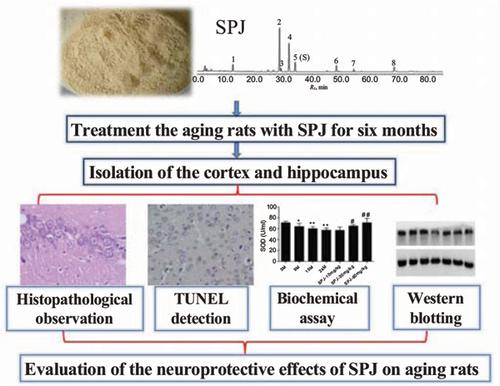Current Pharmaceutical Biotechnology ( IF 2.2 ) Pub Date : 2020-06-30 , DOI: 10.2174/1389201021666191216114815 Jing-Zhi Wan 1 , Rui Wang 1 , Zhi-Yong Zhou 1 , Li-Li Deng 1 , Chang-Cheng Zhang 1 , Chao-Qi Liu 1 , Hai-Xia Zhao 1 , Cheng-Fu Yuan 1 , Yu-Min He 1 , Yao-Yan Dun 1 , Ding Yuan 1 , Ting Wang 1, 2

|
Background: Oxidative stress and mitochondrial dysfunction play a vital role in the pathogenesis of brain aging. Saponins from Panax japonicus (SPJ) have attracted much attention for their potential to attenuate age-related oxidative stress as the main ingredient in rhizomes of Panax japonicus.
Objective: This study aimed to investigate the neuroprotective effects of SPJ on natural aging rats as well as the underlying mechanisms regarding oxidative stress and mitochondrial pathway.
Methods: Sprague-Dawley rats were divided into control groups (3-, 9-, 15- and 24-month old groups) and SPJ-treated groups. For SPJ-treated groups, SPJ were orally administrated to 18-month old rats at doses of 10 mg/kg, 30 mg/kg and 60 mg/kg once daily. Control groups were given the same volume of saline. After the treatment with SPJ or saline for six months, the cortex and hippocampus were rapidly harvested and deposited at -80°C after the rats were decapitated under anesthesia. The neuroprotective effects of SPJ were estimated by histopathological observation, TUNEL detection, biochemical determination and western blotting.
Results: SPJ improved pathomorphological changes in neuronal cells and decreased apoptosis in the cortex and hippocampus of aging rats, increased the activities of superoxide dismutase (SOD), glutathione peroxidase (GSH-Px), Na+/K+-ATPase, Ca2+-ATPase and Ca2+/Mg2+-ATPase whereas, decreased malondialdehyde (MDA) contents in the cortex of aging rats. Furthermore, the SPJ increased silent mating type information regulation 2 homolog-1 (SIRT1) protein expression, decreased acetylated level of peroxisome proliferator-activated receptor-γ coactivator-1α (PGC-1α) in the cortex and hippocampus of aging rats, and reversed the aging-induced decline of Forkhead box O3 (Foxo3a), Superoxide Dismutase 2 (SOD2), microtubule-associated protein light chain 3 (LC3II) and Beclin1 levels in the cortex and hippocampus.
Conclusion: Our data showed that SPJ conferred neuroprotection partly through the regulation of oxidative stress and mitochondria-related pathways in aging rats.
中文翻译:

人参中的皂苷通过线粒体相关的氧化应激和自噬作用赋予大鼠抗衰老的神经保护作用。
背景:氧化应激和线粒体功能障碍在脑衰老的发病机制中起着至关重要的作用。来自人参的皂苷因其减缓与年龄有关的氧化应激的潜力而备受关注,后者是人参根茎中的主要成分。
目的:本研究旨在探讨SPJ对自然衰老大鼠的神经保护作用以及其氧化应激和线粒体途径的潜在机制。
方法:将Sprague-Dawley大鼠分为对照组(3、9、15、24个月大组)和SPJ治疗组。对于用SPJ治疗的组,每天一次以10 mg / kg,30 mg / kg和60 mg / kg的剂量对18个月大的大鼠口服SPJ。对照组给予相同体积的盐水。用SPJ或生理盐水处理6个月后,在麻醉下使大鼠断头后,迅速收获皮质和海马并沉积在-80°C下。通过组织病理学观察,TUNEL检测,生化测定和蛋白质印迹评估SPJ的神经保护作用。
结果:SPJ可改善衰老大鼠神经元细胞的病理形态学变化并减少其皮质和海马的细胞凋亡,增加超氧化物歧化酶(SOD),谷胱甘肽过氧化物酶(GSH-Px),Na + / K + -ATPase,Ca2 + -ATPase和Ca2 +的活性/ Mg2 + -ATPase,而降低衰老大鼠皮质中的丙二醛(MDA)含量。此外,SPJ增加了衰老大鼠皮质和海马中沉默交配型信息调节2 homolog-1(SIRT1)蛋白的表达,降低了过氧化物酶体增殖物激活的受体-γcoactivator-1α(PGC-1α)的乙酰化水平,并逆转老化引起的前额箱O3(Foxo3a),超氧化物歧化酶2(SOD2),微管相关蛋白轻链3(LC3II)和Beclin1在皮质和海马中的下降。
结论:我们的数据表明,SPJ可以通过调节衰老大鼠的氧化应激和线粒体相关途径来赋予神经保护作用。











































 京公网安备 11010802027423号
京公网安备 11010802027423号